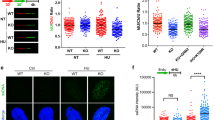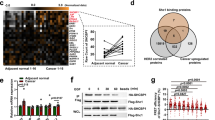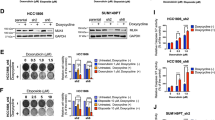Abstract
In response to γ-irradiation (IR)-induced DNA damage, activation of cell cycle checkpoints results in cell cycle arrest, allowing time for DNA repair before cell cycle re-entry. Human cells contain G1 and G2 cell cycle checkpoints. While G1 checkpoint is defective in most cancer cells, commonly due to mutations and/or alterations in the key regulators of G1 checkpoint (for example, p53, cyclin D), G2 checkpoint is rarely impaired in cancer cells, which is important for cancer cell survival. G2 checkpoint activation involves activation of ataxia telangiectasia-mutated (ATM)/ATM- and rad3-related (ATR) signalings, which leads to the inhibition of Cdc2 kinase and subsequent G2/M cell cycle arrest. Previous studies from our laboratory show that G2 checkpoint activation following IR exposure of MCF-7 breast cancer cells is dependent on the activation of extracellular signal-regulated protein kinase 1 and 2 (ERK1/2) signaling. As HER receptor tyrosine kinases (RTKs), which have important roles in cell proliferation and survival, have been shown to activate ERK1/2 signaling in response to various stimuli, we investigated the role of HER RTKs in IR-induced G2/M checkpoint response in breast cancer cells. Results of the present studies indicate that IR exposure resulted in a striking increase in the phosphorylation of HER1, HER2, HER3 and HER4 in MCF-7 cells, indicative of activation of these proteins. Furthermore, specific inhibition of HER2 using an inhibitor, short hairpin RNA and dominant-negative mutant HER2 abolished IR-induced activation of ATM/ATR signaling, phosphorylation of Cdc2-Y15 and subsequent induction of G2/M arrest. Moreover, the inhibition of HER2 also abrogated IR-induced ERK1/2 phosphorylation. In contrast, inhibition of HER1 using specific inhibitors or decreasing expression of HER3 or HER4 using short hairpin RNAs did not block the induction of G2/M arrest following IR. These results suggest an important role of HER2 in the activation of G2/M checkpoint response following IR.
This is a preview of subscription content, access via your institution
Access options
Subscribe to this journal
Receive 50 print issues and online access
$259.00 per year
only $5.18 per issue
Buy this article
- Purchase on Springer Link
- Instant access to full article PDF
Prices may be subject to local taxes which are calculated during checkout









Similar content being viewed by others
References
Kuntz K, O’Connell MJ . The G2 DNA damage checkpoint: could this ancient regulator be the Achilles heel of cancer? Cancer Biol Ther 2009; 8: 1433–1439.
Kastan MB, Onyekwere O, Sidransky D, Vogelstein B, Craig RW . Participation of p53 protein in the cellular response to DNA damage. Cancer Res 1991; 51: 6304–6311.
Motoyama N, Naka K . DNA damage tumor suppressor genes and genomic instability. Curr Opin Genet Dev 2004; 14: 11.
Smits VA, Medema RH . Checking out the G(2)/M transition. Biochim Biophys Acta 2001; 1519: 1–12.
Rhind N, Furnari B, Russell P . Cdc2 tyrosine phosphorylation is required for the DNA damage checkpoint in fission yeast. Genes Dev 1997; 11: 504–511.
Kharbanda S, Saleem A, Datta R, Yuan ZM, Weichselbaum R, Kufe D . Ionizing radiation induces rapid tyrosine phosphorylation of p34cdc2. Cancer Res 1994; 54: 1412–1414.
O'Connell MJ, Raleigh JM, Verkade HM, Nurse P . Chk1 is a wee1 kinase in the G2 DNA damage checkpoint inhibiting cdc2 by Y15 phosphorylation. EMBO J 1997; 16: 545–554.
Lundgren K, Walworth N, Booher R, Dembski M, Kirschner M, Beach D . Mik1 and wee1 cooperate in the inhibitory tyrosine phosphorylation of cdc2. Cell 1991; 64: 1111–1122.
Parker LL, Atherton-Fessler S, Piwnica-Worms H . P107wee1 is a dual-specificity kinase that phosphorylates p34cdc2 on tyrosine 15. Proc Natl Acad Sci USA 1992; 89: 2917–2921.
Bulavin DV, Higashimoto Y, Demidenko ZN, Meek S, Graves P, Phillips C et al. Dual phosphorylation controls Cdc25 phosphatases and mitotic entry. Nat Cell Biol 2003; 5: 545–551.
Kastan MB, Bartek J . Cell-cycle checkpoints and cancer. Nature 2004; 432: 316–323.
Prigent C, Dimitrov S . Phosphorylation of serine 10 in histone H3, what for? J Cell Sci 2003; 116: 3677–3685.
Xu B, Kastan MB . Analyzing cell cycle checkpoints after ionizing radiation. Methods Mol Biol 2004; 281: 283–292.
Hendzel MJ, Wei Y, Mancini MA, Van Hooser A, Ranalli T, Brinkley BR et al. Mitosis-specific phosphorylation of histone H3 initiates primarily within pericentromeric heterochromatin during G2 and spreads in an ordered fashion coincident with mitotic chromosome condensation. Chromosoma 1997; 106: 348–360.
Sauve DM, Anderson HJ, Ray JM, James WM, Roberge M . Phosphorylation-induced rearrangement of the histone H3 NH2-terminal domain during mitotic chromosome condensation. J Cell Biol 1999; 145: 225–235.
Xu B, Kim ST, Lim DS, Kastan MB . Two molecularly distinct G(2)/M checkpoints are induced by ionizing irradiation. Mol Cell Biol 2002; 22: 1049–1059.
Yan Y, Black CP, Cowan KH . Irradiation-induced G2/M checkpoint response requires ERK1/2 activation. Oncogene 2007; 26: 4689–4698.
Navolanic PM, Steelman LS, McCubrey JA . EGFR family signaling and its association with breast cancer development and resistance to chemotherapy (Review). Int J Oncol 2003; 22: 237–252.
Hersey P, Zhuang L, Zhang XD . Current strategies in overcoming resistance of cancer cells to apoptosis melanoma as a model. In: Kwang WJ (ed) International Review of Cytology Vol. 251. Academic Press: New York, NY, 2006, pp 131–158.
Yamaguchi H, Chang SS, Hsu JL, Hung MC . Signaling cross-talk in the resistance to HER family receptor targeted therapy. Oncogene 2013; 33: 1073–1081.
Boucher MJ, Morisset J, Vachon PH, Reed JC, Laine J, Rivard N . MEK/ERK signaling pathway regulates the expression of Bcl-2, Bcl-X(L), and Mcl-1 and promotes survival of human pancreatic cancer cells. J Cell Biochem 2000; 79: 355–369.
Abbott DW, Holt JT . Mitogen-activated protein kinase kinase 2 activation is essential for progression through the G2/M checkpoint arrest in cells exposed to ionizing radiation. J Biol Chem 1999; 274: 2732–2742.
Tang D, Wu D, Hirao A, Lahti JM, Liu L, Mazza B et al. ERK activation mediates cell cycle arrest and apoptosis after DNA damage independently of p53. J Biol Chem 2002; 277: 12710–12717.
Kolb RH, Greer PM, Cao PT, Cowan KH, Yan Y . ERK1/2 signaling plays an important role in topoisomerase II poison-induced G2/M checkpoint activation. PLoS ONE 2012; 7: e50281.
Yan Y, Spieker RS, Kim M, Stoeger SM, Cowan KH . BRCA1-mediated G2/M cell cycle arrest requires ERK1/2 kinase activation. Oncogene 2005; 24: 3285–3296.
Yan Y, Greer PM, Cao PT, Kolb RH, Cowan KH . RAC1 GTPase plays an important role in gamma-irradiation induced G2/M checkpoint activation. Breast Cancer Res 2012; 14: R60.
Yan Y, Haas JP, Kim M, Sgagias MK, Cowan KH . BRCA1-induced apoptosis involves inactivation of ERK1/2 activities. J Biol Chem 2002; 277: 33422–33430.
Linggi B, Carpenter G . ErbB receptors: new insights on mechanisms and biology. Trends Cell Biol 2006; 16: 649–656.
Rexer BN, Arteaga CL . Intrinsic and acquired resistance to HER2-targeted therapies in HER2 gene-amplified breast cancer: mechanisms and clinical implications. Crit Rev Oncogen 2012; 17: 1–16.
Dhomen NS, Mariadason J, Tebbutt N, Scott AM . Therapeutic targeting of the epidermal growth factor receptor in human cancer. Crit Rev Oncogen 2012; 17: 31–50.
Baselga J, Arteaga CL . Critical update and emerging trends in epidermal growth factor receptor targeting in cancer. J Clin Oncol 2005; 23: 2445–2459.
Goldkorn T, Balaban N, Shannon M, Matsukuma K . EGF receptor phosphorylation is affected by ionizing radiation. Biochim Biophys Acta 1997; 1358: 289–299.
Lee H-C, An S, Lee H, Woo S-H, Jin H-O, Seo S-K et al. Activation of epidermal growth factor receptor and its downstream signaling pathway by nitric oxide in response to ionizing radiation. Mol Cancer Res 2008; 6: 996–1002.
Kiyozuka M, Akimoto T, Fukutome M, Motegi A, Mitsuhashi N . Radiation-induced dimer formation of EGFR: implications for the radiosensitizing effect of cetuximab. Anticancer Res 2013; 33: 4337–4346.
Nyati MK, Maheshwari D, Hanasoge S, Sreekumar A, Rynkiewicz SD, Chinnaiyan AM et al. Radiosensitization by Pan ErbB inhibitor CI-1033 in vitro and in vivo. Clin Cancer Res 2004; 10: 691–700.
Liang K, Lu Y, Jin W, Ang KK, Milas L, Fan Z . Sensitization of breast cancer cells to radiation by trastuzumab. Mol Cancer Therap 2003; 2: 1113–1120.
Geoerger B, Gaspar N, Opolon P, Morizet J, Devanz P, Lecluse Y et al. EGFR tyrosine kinase inhibition radiosensitizes and induces apoptosis in malignant glioma and childhood ependymoma xenografts. Int J Cancer 2008; 123: 209–216.
Subik K, Lee JF, Baxter L, Strzepek T, Costello D, Crowley P et al. The expression patterns of ER, PR, HER2, CK5/6, EGFR, Ki-67 and AR by immunohistochemical analysis in breast cancer cell lines. Breast Cancer (Auckl) 2010; 4: 35–41.
Reinhardt HC, Yaffe MB . Kinases that control the cell cycle in response to DNA damage: Chk1, Chk2, and MK2. Curr Opin Cell Biol 2009; 21: 245–255.
Xu B, Kim S, Kastan MB . Involvement of Brca1 in S-phase and G(2)-phase checkpoints after ionizing irradiation. Mol Cell Biol 2001; 21: 3445–3450.
Slichenmyer WJ, Elliott WL, Fry DW . CI-1033, a pan-erbB tyrosine kinase inhibitor. Semin Oncol 2001; 28: 80–85.
Levitzki A, Gazit A . Tyrosine kinase inhibition: an approach to drug development. Science 1995; 267: 1782–1788.
Arteaga Carlos L, Engelman Jeffrey A . ERBB receptors: from oncogene discovery to basic science to mechanism-based cancer therapeutics. Cancer Cell 2014; 25: 282–303.
Jani JP, Finn RS, Campbell M, Coleman KG, Connell RD, Currier N et al. Discovery and pharmacologic characterization of CP-724,714, a selective ErbB2 tyrosine kinase inhibitor. Cancer Res 2007; 67: 9887–9893.
Yan Y, Cao PT, Greer PM, Nagengast ES, Kolb RH, Mumby MC et al. Protein phosphatase 2A has an essential role in the activation of gamma-irradiation-induced G2/M checkpoint response. Oncogene 2010; 29: 4317–4329.
Lee MS, Igawa T, Yuan TC, Zhang XQ, Lin FF, Lin MF . ErbB-2 signaling is involved in regulating PSA secretion in androgen-independent human prostate cancer LNCaP C-81 cells. Oncogene 2003; 22: 781–796.
Schmidt-Ullrich RK, Mikkelsen RB, Dent P, Todd DG, Valerie K, Kavanagh BD et al. Radiation-induced proliferation of the human A431 squamous carcinoma cells is dependent on EGFR tyrosine phosphorylation. Oncogene 1997; 15: 1191–1197.
Meng TC, Fukada T, Tonks NK . Reversible oxidation and inactivation of protein tyrosine phosphatases in vivo. Mol Cell 2002; 9: 387–399.
Leach JK, Van Tuyle G, Lin PS, Schmidt-Ullrich R, Mikkelsen RB . Ionizing radiation-induced, mitochondria-dependent generation of reactive oxygen/nitrogen. Cancer Res 2001; 61: 3894–3901.
Prahallad A, Sun C, Huang S, Di Nicolantonio F, Salazar R, Zecchin D et al. Unresponsiveness of colon cancer to BRAF(V600E) inhibition through feedback activation of EGFR. Nature 2012; 483: 100–103.
Turke AB, Song Y, Costa C, Cook R, Arteaga CL, Asara JM et al. MEK inhibition leads to PI3K/AKT activation by relieving a negative feedback on ERBB receptors. Cancer Res 2012; 72: 3228–3237.
Acknowledgements
We thank Dr Helen Piwnica-Worms for the GST-Cdc25C construct, Dr Ming-Fong Lin for the HER2-mut, wild-type HER2 and control constructs, Victoria Smith and Dr Charles Kuzynski for assistance with FACS analysis and Dr Janina Baranowska-Kortylewicz for assistance with the Mark I 68A Cesium-137 Irradiator. This work was supported by Nebraska DHHS-LB506 Grant 2010-40 to YY, NCI Training Grant (NCI T32 CA009476) to RK and NCI Cancer Center Support Grant (P30CA036727) to KC.
Author information
Authors and Affiliations
Corresponding authors
Ethics declarations
Competing interests
The authors declare no conflict of interest.
Additional information
Supplementary Information accompanies this paper on the Oncogene website
Supplementary information
Rights and permissions
About this article
Cite this article
Yan, Y., Hein, A., Greer, P. et al. A novel function of HER2/Neu in the activation of G2/M checkpoint in response to γ-irradiation. Oncogene 34, 2215–2226 (2015). https://doi.org/10.1038/onc.2014.167
Received:
Revised:
Accepted:
Published:
Issue Date:
DOI: https://doi.org/10.1038/onc.2014.167
This article is cited by
-
Celastrol mediates autophagy and apoptosis via the ROS/JNK and Akt/mTOR signaling pathways in glioma cells
Journal of Experimental & Clinical Cancer Research (2019)
-
Somatic mutation signatures in primary liver tumors of workers exposed to ionizing radiation
Scientific Reports (2019)
-
State-of-the-art strategies for targeting the DNA damage response in cancer
Nature Reviews Clinical Oncology (2019)
-
A novel function of hepatocyte growth factor in the activation of checkpoint kinase 1 phosphorylation in colon cancer cells
Molecular and Cellular Biochemistry (2017)



